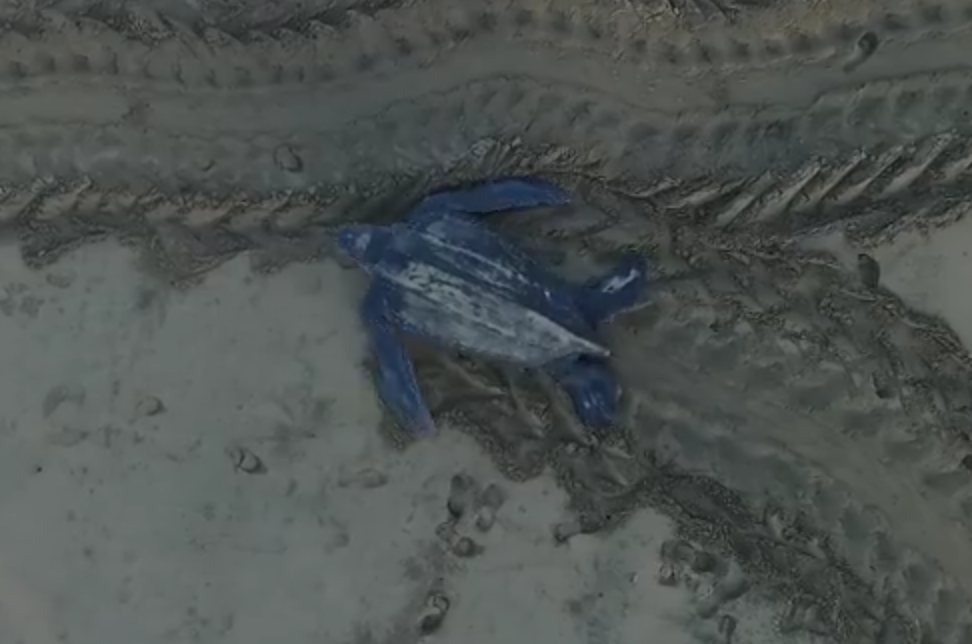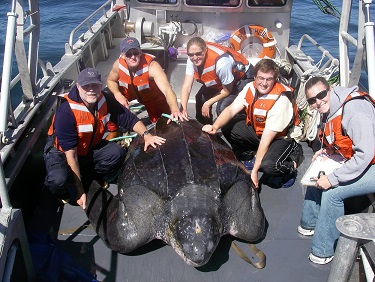Drone Video: Giant, Critically Endangered Leatherback Sea Turtle Swims Through Sand Back to Sea

(EnviroNews World News) — A simply delightful drone video was posted by sea life conservation group the Leatherback Trust on March 21, 2017, showing a rather large East Pacific leatherback turtle (Dermochelys coriacea) swimming with swan-like grace, not through water, but over a sandy beach on its way back to sea after nesting.
The video was shot by Jenell Black, Field Manager with the Leatherback Trust, at Parque Nacional Marino Las Baulas in Costa Rica, which represents one of the “most important nesting beaches for the East Pacific leatherback turtle,” the non-profit organization said on it’s Facebook Page.
The species is listed by the International Union for Conservation of Nature (IUCN) as “critically endangered,” on the organization’s “Red List,” with World Wildlife Fund (WWF) estimating as few as 2,300 adult females remain in the wild. “The Park protects the last mass-nesting beach for the East Pacific leatherback turtle,” Black said.
“What is so very exciting about using the drone is that we are able to not only see how the leatherback moves on land, but how graceful she is once she’s in the water clear of the shore,” Black said in a blog post.
Dr. Jim Spotila and Dr. Frank Paladino, Founders of the Leatherback Trust, were instrumental in the National Park designation of Las Baulas. Their hard work to preserve the beaches and the park itself followed a devastating event in the late 1980s. While attempting to collect standardized data on nesting turtles there, egg poachers, who had organized themselves into sneaky covert units, plucked the beach clean of “every last leatherback egg.” The sad episode resulted in the loss of an entire generation of East Pacific leatherbacks, but also lit a motivating fire to preserve the park — and the species as a whole. Today, some thirty years later, there is virtually no egg poaching in the park, but this species faces threats far beyond thuggish egg snatchers.
The Eastern Pacific subpopulation is the most endangered variety of sea turtle on earth, and is also the largest, with adults weighing as much as a whopping 2,000 pounds according to the National Oceanic and Atmospheric Administration (NOAA). Researchers say the subpopulation’s numbers have plummeted by 98 percent since 1990 — a fact that has NGOs, citizens and companies scrambling to save the species and prevent further decline.

The threats facing the Eastern Pacific leatherback are myriad, and include warming oceans from climate change, collisions with propellers, plastic pollution, fishing lines, trawling traps, loss of nesting habitat, and last but not least, harvesting of turtles and eggs by humans for food.
Leatherback Sea turtles are ancient amazing animals that can live to be over 100 years old in favorable conditions. Amazingly, the creatures live on a mostly jellyfish diet, and migrate thousands of miles to nest on beaches like Playa Grande — the beach featured in Black’s drone video.
Unlike other turtles, leatherbacks lack a hard bone-like shell, being housed instead in a shell of “leathery oil-saturated connective tissue overlaying loosely interlocking dermal bones,” which may make them even more vulnerable to things like boat propellers. The creatures can dive to depths up to 4,200 feet and are able to stay submerged for an hour-and-a-half.
Over the past two years, EnviroNews World News has covered two separate stories featuring grueling video episodes where the Leatherback Trust had to rescue poor sea turtles with plastic utensils lodged in their sizable nostrils. Now, lovers of wildlife and conservation groups alike, are cheering for the Leatherback Trust to continue its fight on behalf of these ancient mild-mannered creatures, the oceanic ecosystem and the planet at large.
MORE ENVIRONEWS STORIES ON SEA TURTLES AND OCEANIC PLASTIC POLLUTION
Video: Watch What One Plastic Straw Does To Endangered Sea Turtle
(EnviroNews World News) – It’s no secret the world’s oceans are now completely littered with plastic due to human activities. By now, many people have also been made aware of the gigantic gyres in the midst of the oceans, where plastic is whirled by currents into massive “garbage…
Video: The Leatherback Trust Saves Yet Another Sea Turtle With Plastic Fork Stuck in Nose
(EnviroNews World News) – First a plastic straw, and now a large plastic fork. These are two of the objects removed from the nostrils of ancient endangered sea turtles this year by researchers. On December 6, 2015, Nathan J. Robinson, Field Director of The Leatherback Trust, was busy…
Zooplankton Filmed Feasting on Fluorescent Plastic Microbeads for First Time
(EnviroNews World News) – Zooplankton have been captured on film feasting on plastic microbeads for the first time New Scientist magazine has reported. The entire three hour event took place inside a single drop of water and was taped under the microscope by Five Films. The unique footage…
FILM AND ARTICLE CREDITS
- Emerson Urry - Journalist, Author



